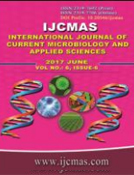


 National Academy of Agricultural Sciences (NAAS)
National Academy of Agricultural Sciences (NAAS)

|
PRINT ISSN : 2319-7692
Online ISSN : 2319-7706 Issues : 12 per year Publisher : Excellent Publishers Email : editorijcmas@gmail.com / submit@ijcmas.com Editor-in-chief: Dr.M.Prakash Index Copernicus ICV 2018: 95.39 NAAS RATING 2020: 5.38 |
Coagulase Negative Staphylococci (CONS) are the indigenous flora of the human skin and mucous membrane. They are usually contaminants, when isolated from clinical specimens. CONS have become important nosocomial pathogens, accounting for 9% of all nosocomial infections. These infections are difï¬Âcult to treat because of the risk factors and the multiple drug resistance of these organisms. A total of 74 clinically significant CONS isolated from pus, urine, blood, sputum, ear swabs. These isolates were initially identified by colony morphology, Gram staining, catalase test, slide coagulase test, tube coagulase test. After conï¬Ârming the isolates as CONS, species-level identiï¬Âcation was performed by simple, non-expensive conventional methods and antibiotic sensitivity testing was also carried out by Kirby-Buer’s disc diffusion method. Among the 74 isolates, S. epidermidis was the most common species isolated, seen in 29.7%, followed by S. hemolyticus (20.2%), S. saprophyticus (14.8%), S. lugdunensis (13.5%), S. capitis (10.8%), S. cohni (4%), S. schleiferi (2.7%), S. xylosus and S. hominis (1.3% each), Most of the isolates showed resistance to penicillin (83.7%) fallowed by Ampicillin (77%), Erythromycin (54%), Cotrimoxazole (27%) gentamicin (16%), amikacin (12%) piperacillin/tazobactum and linezolide (3% each). The increased recognition of pathogenic potential in CONS and emergence of drug resistance among them demonstrates the need to adopt simple laboratory methods to identify the species and determine the antibiotic resistant patterns. It will help the clinicians in treating the infections caused by CONS.
 |
 |
 |
 |
 |